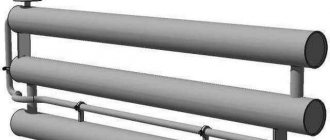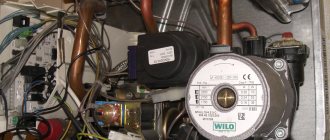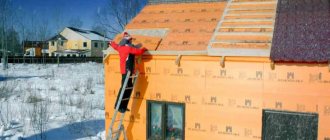
A high level of comfort in a country house is impossible without heating. If before the choice was small: firewood or electricity, now there are much more options. Any prudent owner wants the chosen method to support the possibility of heating a large area of the room, be safe, and not hit on the budget. In order not to be mistaken with the choice, we will consider each heating option in more detail.
Gas heating
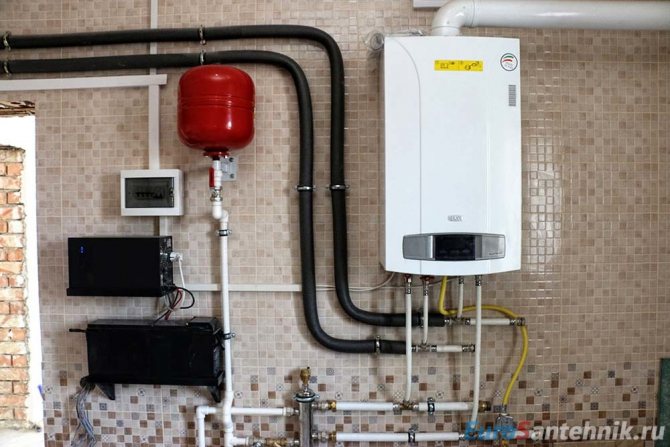

Gas heating is ideal for a country house. Round-the-clock warmth in the house at minimal cost - what else is needed. This type has a significant number of advantages:
- acceptable price;
- the ability to select the optimal boiler power depending on the heated area;
- the presence of a thermostat to control the level of heat;
- high equipment reliability;
- long service life of equipment;
- there is no need to regularly monitor the equipment and clean it.
There were also some drawbacks:
- permits are required due to the high risk;
- regular inspection of equipment by specialists is required;
- since carbon dioxide is emitted, ventilation is needed.
Of course, gas heating in a country house is possible if the main gas pipeline is connected. Unfortunately, the level of gasification in Russia is still at a negligible level. When it comes to the inexpediency of building a highway or remote areas, you can forget about gas.
There is an option of installing an autonomous gas tank, that is, a gas storage tank. In this case, all the advantages of gas heating are preserved, besides, complete independence of the owner of a country house is added.
But the gas tank requires increased accuracy and compliance with safety rules. For example, it is forbidden to fill a container with gas by more than 85%. To this you need to add regular inspections and considerable costs for installing and filling the cylinder.
Water heating system for permanent residence in the country
This method of heating with a heating boiler ensures an even distribution of heat throughout all rooms and floors, creating comfortable conditions inside the entire house.
According to the method of heating water, boilers are divided into:
- gas;
- electrical;
- on liquid fuel (diesel fuel);
- on solid fuels (coal, firewood, peat).
http:
Together with a network of radiators (batteries) branched throughout the house, such a boiler system provides complete heating of the entire summer cottage.
The approximate boiler capacity of the system, depending on the area of the house, can be determined from the table:
| House area, m2 | 60-200 | 200-300 | 300-600 | 600-1200 |
| Boiler power, kW | up to 25 | 26-30 | 31-60 | 61-100 |
The most reliable and simple scheme is the following closed circuit: water is heated in the boiler, flows through pipes to the radiators, through which heat is transferred to the rooms, and then returns back to the boiler.
The circulation of water in the system can be natural (under the action of gravity) or forced by means of a pump. In addition to pipes, a boiler and batteries, the installation of a water heating system provides for such devices and devices as: an expansion tank (to drain excess water when it is heated), a pressure gauge (to measure the pressure in the system), thermostats (to automatically maintain the temperature of the coolant), safety valves ( relieve excess pressure).
http:
So, depending on the mode of using the cottage, choose one of the proposed heating systems for a country house.
nastroikezhenshinenemesto.ru
Electric heating
The first option that comes to mind when gas heating is impossible is electric heating.
With him, things are much simpler: since there is no risk of explosion, the number of permits for installation is reduced. There are 3 methods of electrical heating:
- beam (heating panels, carbon heaters);
- convective (oil radiators, convectors);
- thermal fans.
The advantages of electric heating include:
- uncomplicated installation;
- there is no need for regular inspection, inspection as needed is sufficient;
- low costs for the purchase of equipment;
- high reliability;
- there are no harmful secretions.
The disadvantages are as follows:
- on average, operation lasts no more than 8 years;
- a huge level of electricity consumption;
- instability in terms of short circuit.
If power outages are common in your area, electrical heating is best avoided. The disadvantage of large cash costs is compensated by special night rates.
Another important point regarding electric heating: so that heat does not seep through the walls, roof and windows, the country house must be well insulated. Then the approximate energy consumption is 1 kW per 10 m².
Electric heaters
If in the locations of the suburban area there is access to electricity, then the seasonal use of electric heating systems is the best option. In order to avoid damage to the electrical appliance or wiring, it is necessary to remember the main condition when connecting - this is the correct choice of the cross-section of the electrical cable that can withstand the power consumption. Such a calculation for a voltage of 220 V can be done independently according to the table for a single-phase copper (2 cores) cable:
| Device power, kW | 1,0 | 2,0 | 2,5 | 3,0 | 3,5 | 4,0 | 4,5 | 5,0 | 6,0 | 8,0 | 9,0 |
| Current strength, Ampere | 4,5 | 9,0 | 11,4 | 13,6 | 15,9 | 18,2 | 20,5 | 22,5 | 27,3 | 36,4 | 40,5 |
| Circuit breaker current, A | 6 | 10 | 16 | 16 | 20 | 20 | 25 | 25 | 32 | 40 | 50 |
| Minimum wire cross-section, mm2 | 1 | 1,5 | 2,5 | 2,5 | 2,5 | 4 | 4 | 4 | 4 | 6 | 10 |
The most suitable for giving are the following electrical appliances:
- convectors;
- oil heaters;
- infrared heaters.
Each type of heater has its own advantages. Therefore, we will dwell on them for this or that case.
Electric heating convectors (floor, wall, universal) work on the principle of natural air exchange without a fan. As a rule, they do not require grounding and are equipped with overheating protection. Simple installation and assembly. Most convectors have an “anti-freeze” mode - maintaining the minimum temperature in the room with the lowest energy consumption.
To independently calculate the required power of the convector for heating your home, you can use the table:
| Heating area, m2 | 5-6 | 7-9 | 10-12 | 13-14 | 15-17 | 18-19 | 20-23 | 24-27 |
| Convector power, kW | 0,5 | 0,75 | 1,0 | 1,25 | 1,5 | 1,75 | 2,0 | 2,5 |
The main advantages of the convector, environmental safety (oxygen is not burned out, air humidity is preserved) and rapid heating of the room (10-15 minutes), made this heater the most popular in summer cottages.
Oil heaters (batteries) are metal radiators filled with mineral oil inside. When connected to the power grid, the oil warms up and gives off heat to the surrounding air. Modern oil-filled heating batteries are equipped with automation (overheating sensor, timer) and displays that allow you to visually control the air temperature. Convenient movement on wheels, reliability in operation, simple installation, a wide range of heated area (up to 25-30 m2) and a low price fully compensate for the large weight and dimensions of the device and make it convenient for use in the country.
http:
Infrared heaters (IR). Infrared devices do not heat the air, but the floor and objects in the zone of the rays. And only then, with their warmth, the objects heat the air.
Acting similarly to the sun's rays, IR is an ideal solution to the issue of heating plants for greenhouses in a summer cottage when it gets cold.Local heating is also applicable in open areas of the summer cottage: a veranda, a gazebo. And the high safety of IR makes them indispensable in basements, garages, baths. Simple installation and assembly. In addition, when approaching the dacha, you can turn on IR via mobile communication using an SMS message.
Heating by heat pump
Heat pumps are high-tech and efficient. Their use has been gaining momentum in recent years. Especially in country houses. The essence of a heat pump is to take energy from water, air and earth. Accordingly, 3 models have been developed: air / water / geothermal.
There are a huge number of pluses:
- long service life, up to 50 years;
- safety: no secretions, dirt, waste;
- economical energy consumption: it releases about 3 times more energy than it absorbs;
- diesel or gasoline is suitable for engine operation (when no electricity is supplied);
- the system is automatic, so there is no need to add water, control;
- the reversible function allows you to heat a country house in cold weather, and cool it in hot weather;
- the requirements of the regulatory authorities are not strict.
Disadvantages are present in a small number:
- expensive: the main disadvantage of heat pumps;
- the compressor works loudly, therefore, the boiler room will have to be soundproofed.
Country house owners - gardeners need to take into account the essential characteristics of heat pumps. They are absorbed by the heat from the earth (geothermal), so the soil is cooled. Heat-loving seedlings on the site may suffer.
Stove heating
A proven old-fashioned method is to heat a country house or dacha with a stove. Now this option is rather an exception. Meanwhile, stove heating is an irreplaceable thing, because:
- reliable and independent of either gas or electricity;
- inexpensive;
- environmentally friendly.
There are a little more disadvantages:
- low efficiency (however, if you place the stove in the center of the house and draw the chimney in the center, you will be able to heat the whole house);
- long heating;
- soot, soot;
- you need to throw up fuel, watch out for coals;
- need a nook for storing firewood.
If you are not satisfied with the stove, you can replace it with a solid fuel boiler. Not only firewood is thrown into such boilers, but also coal, peat, sawdust. The advantages of solid fuel boilers are consonant with the advantages of stove heating. The disadvantages, respectively, are the same.
Experienced owners of country houses note that the best option for heating a country house often consists of a combination of several methods. A stove heating or a solid fuel boiler is perfectly combined with electric heating. During the day, the stove is used, and at night there is a transition to electric heating at a reduced rate. It will cost a little more, but one option insures the other, and various force majeure is not terrible.
Another great option is a combination boiler. The combinations are different, for example, gas + wood, electricity + wood. The advantage is that the first type of heating is easily replaced by the second. The built-in automation independently controls the fuel transitions.
House heating
In the absence of a main gas pipeline to the house and frequent power outages, alternative heating sources are used.
Solid fuel
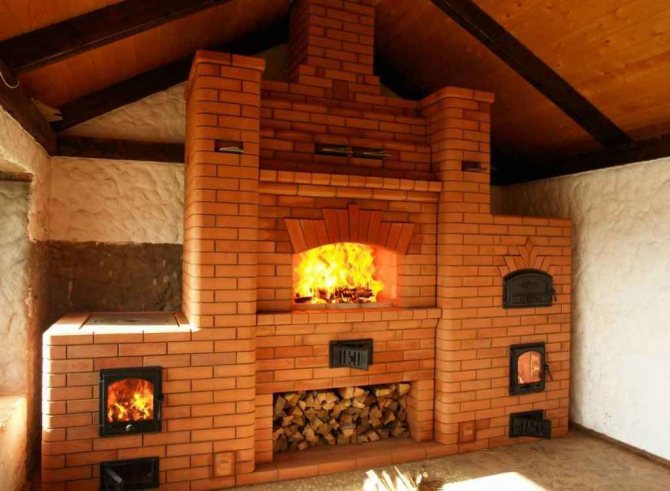

Firewood, peat briquettes, coal or pellets are used as solid fuel.
Positive aspects of using solid fuels:
- low price of firewood and peat briquettes;
- the possibility of self-preparation of firewood;
- low price of ovens;
- the possibility of making brick or metal stoves with your own hands;
- the ash remaining after firing the stoves is used as a valuable fertilizer in the garden.
Disadvantages of using solid fuel:
- the calorific value of solid fuel is low, therefore, large reserves are required for uninterrupted heating during the heating season;
- solid fuel burns well only in dry form, therefore, a sealed shed, bunker or woodshed is needed to store it;
- after using solid fuel, a lot of sawdust, chips or dust remains in the room;
- solid fuel stoves need daily loading;
- household solid fuel heating systems are not controlled by automation;
- annual maintenance and cleaning of chimneys from soot and ash is necessary;
- a properly assembled chimney is required for the operation of solid fuel heating systems;
- a lot of ash remains from the furnace firebox, which must be removed regularly.
Liquid fuel
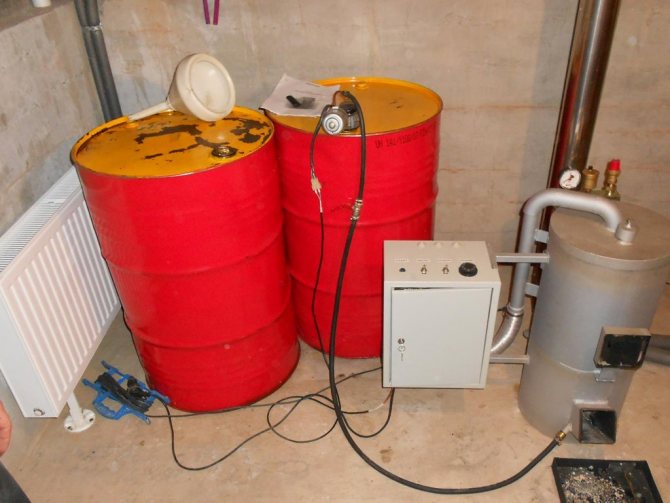

Diesel fuel, kerosene, mining, vegetable oil from fast food, the remains of animal fat, crude oil are used as liquid fuel. Furnaces are installed to heat indoor air or are used to heat the coolant in radiators.
Positive aspects of using liquid fuels:
- liquid fuels are always on sale;
- used oil is easy and cheap to purchase at the nearest vehicle service station;
- it is easy to make a stove that runs on waste oil;
- liquid fuels are easy to store and transport.
Disadvantages of using liquid fuel:
- high price of diesel fuel;
- the chimney of a stove running on diesel fuel quickly becomes clogged with soot;
- liquid fuel heat generator requires periodic maintenance by specialists;
- diesel fuel has a strong unpleasant odor, therefore, a separate non-residential room is required for the operation of a liquid-fuel apparatus.
Liquefied petroleum gas


A mixture of propane and butane is used as liquefied gas. They purchase it by refueling 50-liter cylinders at a gas station. Infrared burners or conventional gas boilers are used as heating devices.
Positive aspects of using liquefied gas:
- gas cylinders are easy to refuel at a gas station;
- there is no dust and debris during the operation of gas heaters;
- no ash remains during gas combustion;
- there is no soot when burning gas. This eliminates the need to clean chimneys;
- the ability to automatically maintain the temperature in the room.
Disadvantages of using gas for heating
- high price for refueling gas cylinders;
- the summer version of the propane-butane mixture freezes in severe frosts;
- gas equipment requires periodic maintenance by gas industry specialists.
Solar heating systems
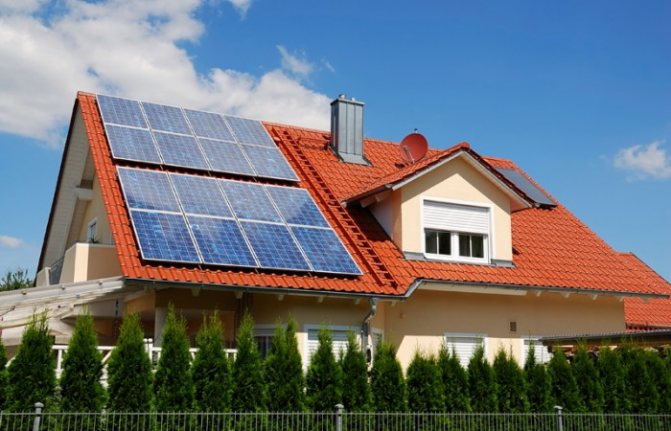

Solar collectors or solar panels are used to heat a country house using solar energy.
Solar collectors consist of a glass tube system with a heat carrier. The equipment is installed on the south side of the wall or roof of the house. During the operation of the solar collector, the coolant is heated by the sun's rays, flows into the house and gives the accumulated energy to the interior.
Solar panels are installed on the south side of the house. When illuminated by the sun, they generate electricity, which is fed into the room through wires. Electric heaters are used to heat the house.
Advantages of solar heating systems:
- free heating of the house;
- does not require expensive regular maintenance;
- when working, they do not emit smoke, soot and soot;
- environmentally friendly heating system.
Disadvantages of solar heating systems:
- low system efficiency;
- in winter, there are few sunny days in northern latitudes, the system does not work efficiently;
- the system works only during the daytime, at night it cannot heat the room;
- high price of equipment.
Due to the low efficiency of solar systems in winter, they are used for additional heating of the room, reducing the cost of heat received from the main system.
On a note! In the steppe regions of the Russian Federation, in order to receive free electricity, small wind farms are installed in addition to solar panels to heat the house.
Heating the house with a heat pump
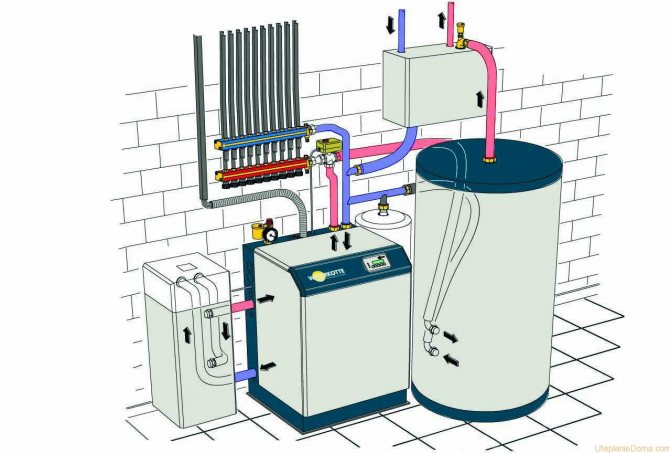

The heat pump is a pipe system with a heat carrier poured inside. On one side of the system, the coolant is heated by natural energy, on the other, it cools down in the radiators of a country house. The source of energy is the sun, hot water or ground water. The system works effectively in the presence of nearby underground geothermal sources.
On a note! The movement of the heated coolant in the system is carried out by an electric pump and requires the constant availability of electricity.
Use of solid biofuels
To heat the room, you can use solid plant waste, thereby disposing of fallen leaves, chopped branches of garden trees, waste from woodworking enterprises (chips and sawdust). To do this, a pyrolysis hot water boiler with radiator wiring around the house is installed in the room.
During operation, the loaded fuel (wood chips, leaves, firewood, branches) is heated without air access. When heated, the fuel emits a combustible gas (a mixture of methane, hydrogen and carbon dioxide), the combustion of which heats the coolant.
Advantages of a pyrolysis heating system:
- very low fuel price;
- absence of heavy metals, sulfur, phosphorus in the emission;
- low content of CO2 in the exhaust;
- quick installation of the pyrolysis heating system;
- pyrolysis heating solves the problem of recycling waste from the gardening and woodworking industry.
Disadvantages of a pyrolysis heating system:
- high price of equipment;
- the installation of the pyrolysis system must be carried out by specialists;
- to pump the coolant through the system, it is advisable to use an electric pump. The absence of a pump complicates and increases the cost of the system.
Use of gaseous biofuels


In the presence of a large amount of animal waste, biogas is used to heat a country house. To do this, a large container is installed next to the room - a bioreactor into which wastes from animal husbandry and the food industry are loaded and water is poured. The container with the solution is hermetically closed and heated to 70 degrees. In the absence of air access, under the influence of anaerobic bacteria, the mixture begins to actively ferment. Fermentation produces a combustible gas, methane. The produced methane is purified and fed through pipes to the burners of gas boilers. The mixture processed by bacteria is dried and used as fertilizer or fuel.
The advantages of biogas heating:
- heating is environmentally friendly;
- waste-free heating;
- high efficiency of the installation: from 5 tons of the mixture, 40 cubic meters of combustible gas can be obtained daily for six months.
Disadvantages of biogas heating:
- a biogas plant has a large volume and a high price;
- for uninterrupted heating, a regular supply of manure is necessary.
Diesel heating
Diesel heating is a safe and quite convenient option for heating a country house, used even in developed European countries.
The advantages of this type of heating include:
- non-explosive fuel, so there is no need for permits;
- a reasonable choice of the boiler will increase the efficiency up to 85-87%;
- economy and efficiency;
- easy and quick installation.
Speaking about the shortcomings, there are:
- strict requirements for the regularity of prevention;
- good quality diesel fuel is required;
- it is necessary to clean the soot from the chimney.
The most significant disadvantage: high cost. High-quality diesel fuel is expensive. During the season, about 5,000 liters of fuel are consumed, which must be purchased.In the boiler room, according to the rules, it is allowed to place a tank of 800 liters. During the season, you have to order a petrol station 4 - 6 times. If the territory permits, it is better to provide an external tank with a volume of 3-4 thousand liters.
As in the situation with electric heating, the heat from diesel fuel will be preserved provided the house is well insulated.
How to heat a modern summer cottage in winter?
Newer buildings use systems that heat up quickly premises of the required area, drain liquid from the pipeline with water heating, have a solid power in order to effectively warm up a house with low thermal insulation properties, and so on. This is about boilers, actively used by the owners of modern country cottages.
With the help of such equipment, constant water circulationheated to a certain temperature through pipes to the batteries and back. During the laying of the pipeline metal, polypropylene or metal-plastic products are used... They are considered to be durable and can last for decades subject to the correct operation of the boiler.
Boilers as the basis of heating systems
Gas boilers are quite common products and attract customers. democratic cost, and fuel availability... They are characterized by maximum automation, high efficiency and reliability. At the same time, some models are installed in the country only in rooms with good ventilation and access to the street.
Photo 1. Scheme of water heating of a summer cottage using a boiler with an additional expansion tank.
Electric boilers are different the most expensive service, but such advantages, such as: convenience and ease of use, simple installation, no open flame (high level of safety). On the other hand, such models, maintaining the temperature, consume too much electricity and need separate wiring in the case of installing three-phase equipment.
The most difficult to maintain considered solid fuel boiler. It is often used in summer cottages as a main or auxiliary heating device. Among pluses emit unpretentiousness to fuel quality, ease of operation and maintenance. Low efficiency and low productivity - limitations such boilers.
The last variety is liquid fuel boilers that have become popular due to their high efficiency and good autonomy. The only one disadvantage considered the high cost of maintenance and the price of consumables
Classified boilers for:
- Copper.
- Cast iron.
- Steel.
Principle of operation boilers are quite simple. The building heats up thanks to an increase in the temperature of the coolant in the heat exchanger structures, after which the water begins to flow from pipes to radiators... When heat is supplied through the air, it comes back and heats up again up to a certain temperature.
Devices are working on liquid, solid or gaseous fuels, some boilers use several types at once. These units have built-in universal burners. When choosing the above devices, it is recommended to pay attention to the maximum power, temperature and type of fuel used, the presence of certain functions, as well as the material of manufacture and other parameters.
Heating with liquefied gas
When a country house is operated infrequently by the owners, small cylinders with liquefied gas up to 50 liters in volume will be an excellent replacement for gas heating or a massive gas tank.


The principle of operation is standard: you need a boiler and low-power convectors. However, for security reasons, there are many installation requirements:
- the distance from the cylinder to the heat source is not less than 1 meter;
- the cylinder is connected to the convector with a steel pipe;
- it is necessary to provide free access to the gas cylinder (it is forbidden to install it in the base);
- store in a standing position.
Most owners are worried about the excessive consumption of liquefied gas. When the area of the house does not exceed 50 m², you will need 2 - 3 cylinders of 50 liters for heating in winter. Of course, the lower the temperature drops in a particular area, the greater the consumption.
How to heat a country house
Currently, there are many ways to heat a country house. When choosing one or another heating scheme, some subtleties should be taken into account. Since country houses were built in different time periods, the building materials that were used to build them may differ from each other. Someone spent a lot of money on the construction of their country house, fully raising a full-fledged structure, and for someone the dacha cost a penny, but at the same time it is not suitable for permanent residence.
Heating a country house largely depends on the building materials that were used in the construction of the premises. If you use heat-resistant panels, plates, then heating will be much easier to arrange than when arranging a dilapidated building.
In addition, when selecting a heating system, it is necessary to take into account the availability of communications. As a rule, most of the dacha villages are located in remote locations from centralized gas pipelines.
When choosing how to economically heat a summer cottage in winter, it is also important to take into account the fact that there is the nearest source of coolant. So, the house can be heated by coal, firewood, diesel fuel, etc.
The most popular type of fuel in Russia for heating country, village and even country houses was and remains firewood. Firstly, their price is lower than any other alternative fuels, and secondly, such resources can always be at hand.
VIDEO: Electric heating. An inexpensive way to heat your home
Varieties of heating systems
Cottage heating options are classified depending on the heat carrier:
- air;
- steam;
- electrical;
- water.
In addition, the heating units are grouped based on the type of fuel:
- liquid fuel - diesel fuel, diesel fuel, etc.;
- gas heaters for summer cottages;
- solid fuel - firewood, coal, pellets, etc.;
- heating the country house with electricity.
Each of these methods of piping a heating block has its own pros and cons. If we talk about the price, then the most expensive will be an oil heating installation. Whereas the cheapest heating system for a country house will be a gas boiler. However, as mentioned above, not all settlements have a centralized gas pipeline.
With this article they read: Alternative to gas heating
In addition, the seasonality of stay in it also affects the choice of the heating system for the country house:
Summer option
A fairly large number of country houses were built from wooden saw cuts. Wall ceilings of such rooms are not able to keep thermal energy inside the structure for a long time. Therefore, if the dacha is not heated, the temperature conditions in the room will be almost identical to those of the street. Wooden buildings can be quickly heated using electric heaters or stove equipment. In this case, you will need to carefully insulate the facade of the building, as well as use a powerful heating unit.
All-season option
The structures that they plan to use regardless of the season are prepared for low temperature conditions even at the design stage. A person who lives in a country house throughout the year has certainly made sure that his home is equipped with all the necessary communications. In such a room, at least, light and water should be conducted.Summer models, as mentioned earlier, are mostly erected from wood or panel panels, while when constructing capital-type buildings, concrete slabs, bricks, cinder blocks and other building materials identical in functionality should be used. And if your country house has the above communications, then an electric boiler will be the most suitable way of arranging a heating system. In the absence of electricity, you can use gas heating or other alternatives.
Stove heating
If you do not know how to heat a summer cottage in the winter without gas and electricity, then you will probably be interested in such an option as a cast iron or steel stove. The first model is preferable due to some of its features:
- durability;
- long-term maintenance of the temperature regime;
- the speed of warming up.
Considering the heating of the stove, it is necessary to take care of the chimney in advance. Indeed, without this structural element, the heating block simply will not function.
The disadvantage of the furnace heating installation: the systematic laying of fuel resources. And if the fuel is not loaded in time, then the fire will go out and you will have to re-ignite the stove. In addition, there is a need for regular cleaning of the furnace from fuel decay products.
For stove heating, beech, oak or hornbeam will be the best material for the firebox. Whereas spruce and pine will not provide the temperature conditions necessary for a full-fledged living.
A good old potbelly stove in a modern design will be an excellent option for a summer residence. An easy-to-use stove, it does an excellent job with the tasks.
Potbelly stove of the 21st century
At present, the technology of long-burning boilers has been developed. Their work is based on the principle of pyrolysis, when wood or any other solid fuel burns at low temperatures with the simultaneous release of pyrolysis gases. They are discharged into a separate chamber, where they additionally burn out with the release of heat. On the one hand, this significantly increases the efficiency of the boiler - almost up to 85 and even up to 90%, on the other hand, the burning time of one bookmark of firewood reaches almost 8 hours.
Read with this article: DIY long-burning solid fuel boiler
Gas heating
A piping using a gas boiler is the most profitable and convenient way to heat a home. However, this option can be used provided it is connected to a centralized gas pipeline. Gas heaters are considered the most effective, since they are able to warm up the room temperature in a fairly short period.
In case there is no connection to the gas main, you can easily connect the heating unit to gas cylinders. Despite their simplicity, such devices are no less popular than stationary heaters of identical functionality. But at the same time, they can be easily transported from place to place. It is for this reason that gas-cylinder heating equipment is considered autonomous.
It is possible to perform piping of the gas heating circuit using natural or forced circulation of the coolant. So, if you have a one-story house, then a system with natural circulation will be enough to provide the necessary temperature conditions in the room. Whereas a more powerful system is required to heat a two-story house, for which you need to use a centrifugal pump.
Read with this article: Heating installation in a private house
www.portaltepla.ru
Which heating is more economical?
The question of saving is the first to come up in line with the owners of country cottages and summer cottages. If we take as an example a house with an area of 90 m², a heating season lasting 8-9 months, an average winter temperature of 20 degrees and an efficiency of 50%, we get the average heating costs:
- gas - 11,000 rubles;
- firewood - 23 thousand rubles.(not chipped);
- electricity - 60,000 rubles (at the daily rate).
It turns out that gas heating will least of all hit the budget, in contrast to electric non-preferential ones. Solid fuels are perfectly acceptable for use.
Alternative ways of heating a summer cottage
Solid fuel boiler for summer cottages
If there is a need to organize effective heating of the country house, but the lack of gas and electricity on the site does not allow solving this problem in the usual way, you will have to use boilers with an alternative energy carrier: on solid (coal, peat, firewood) and liquid fuel (diesel fuel, gasoline) they are suitable for this role is the best possible.
Of course, the heat produced by them will cost significantly more than that of a gas boiler. But given the fact that its tasks do not include heating large rooms in a harsh winter and the ability to work on a non-standard energy carrier, such a model can be the best option for country houses located in remote places.
Whether to fill in antifreeze
When the temperature drops to zero, the water expands by about 11%. It is easy to imagine what is happening with the pipes. Antifreeze added to the water increases the viscosity of the water several times and reduces the expansion ratio. In other words, antifreeze is a salvation for the heating system.
Prudent owners who do not live in a country house in the winter should definitely take care of pouring antifreeze.
But in pursuit of the safety of the heating system, do not forget about the safety of the water supply system. If it is a tee, before the cold weather, have time to drain the water. Then the water pipes will not be damaged. Antifreeze in the heating system will be useless if the country cottage has warm water floors.
The best option is to maintain the standby heating of a country house in winter at a level of 9 - 12 degrees.
Antifreezes last 5 - 8 years on average. Then acetic acid is released, which eats up the radiators. Don't forget to change in time.
Output
Calculate everything thoroughly: the area of the room, average temperatures, the availability of gas and solid fuel, the number of days per year when you are in a country house.
Whatever heating choice you choose, good building insulation will keep the heat inside the house. Consider using several heating methods at the same time: this will save you from unforeseen situations. Do not neglect regular inspections of the equipment in order to increase its life and personal safety.

